Like every living thing on the planet earth, bees have a certain need for water.
It is important for every beekeeper to keep bees healthy and strong, and in order for them to really be that, apart from food, they need to be provided with fresh and drinkable water.
Unfortunately, beekeepers always think about food, but we forget that thirst is much more dangerous to bees than hunger.
The best source of water for bees is an unpolluted stream in the immediate vicinity of the apiary, but as not every apiary is located near the stream, the beekeeper should provide a healthy source of water for his bees. It is most often a bee waterer.
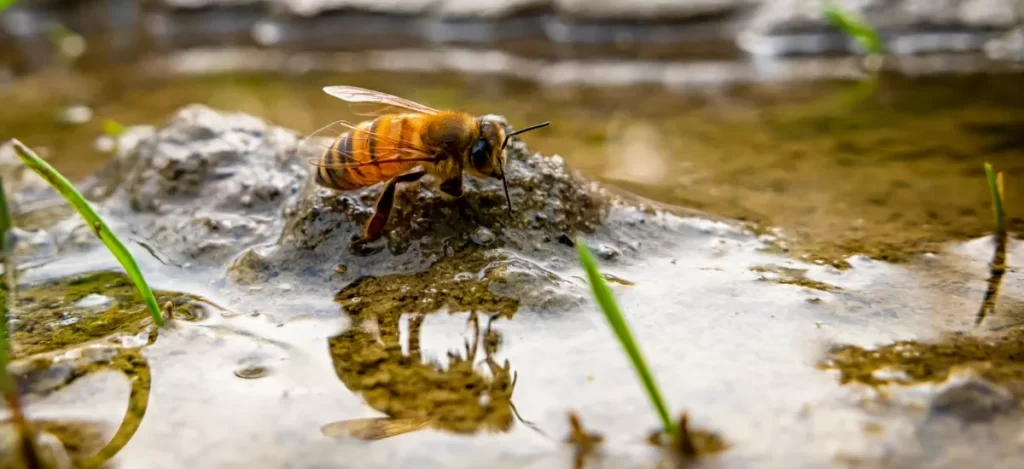
Do Bees Drink Water?
Imagine how hard bees work. On average, they visit at least 2,000 flowers a day, with small wings that swing 10,000 times a minute, and carry pollen to the hive where they use pollen, wax and their saliva to make honey.
The whole cycle is repeated daily. On such a busy day, bees are thirsty and need a safe source of water. But water is not always available and this is a big problem for bees.
Why Do Bees Need Water?
Bees need water which they get nearby for the hive. In the hive, water is used for honey production and for the daily life of the colony.
The body cells of the bee are interconnected, and the whole organism of the bee is filled with water. The body of a bee contains four-fifths of water. Therefore, all biochemical processes take place in water.
Water plays an important role in controlling the temperature and humidity in the hive. These conditions are especially important for the brood. If the temperature in the hive rises, there may be a problem with the brood. The optimum temperature is 35 ° C.
Nurse honey bees feed on developing larvae (known as baby bees) with food from water, pollen, nectar and royal jelly. This diet can contain up to 80% water on the first day!
Read article: Feeding Bees In Winter – Tips For Feeding
Bees use water to dilute the honey they eat. Sometimes the honey will crystallize or become too thick. When this happens, the bees use water to dilute the honey and make it drinkable again.
Bees need water for their own digestion, as well as for all other living things. Developing bees also need water along with other nutrients from pollen and honey.
The amount of water in the bee community varies very little and it is necessary to constantly compensate for any loss of water caused by breathing or excretion of digested food.
How Much Water Do Bees Need?
The needs of the bee community for water depend on the season, weather conditions, amount of brood and the strength of bee community.
It is estimated that the daily water needs of the average bee community during the active season are between 200 and 300 ml.
The average monthly water consumption per bee community in a season is 2-3 l (not counting the water that bees get by processing nectar).
How Do Bees Collect Water?
Every day a certain number of bees are responsible for collecting water for the hive. The bee collects water in itself and then, returning to the hive, leaves the water where it is needed. The bee, which is in charge of water, collects about 25 mg of water during one flight. When inspecting the bee community, the beekeeper can spray some water on the bees.
When choosing and deciding on the source of water for the apiary, it is important to take into account the size of the apiary itself.
How To Provide Bees With Clean Water?
The need for water in bees is significant, already at the appearance of the first brood, at the beginning of February.
Bees need shallow water to be able to drink, because otherwise there is a danger of drowning. However, the problem with shallow water is that it evaporates quickly.
Natural water sources, such as rivers and lakes are also not a good option because in addition to drowning, bees are threatened by many other dangers. They can end up as food for fish, frogs, and other wildlife.
If you can, make a small lake (not deep) in an apiary with flowers. This is also one of the options as a source of water, but great care must be taken to the hygienic properness of the water in this case.
Also, a floating object should be placed in the water on which the bees could stand and drink water and thus not be able to drown. But it is also important to emphasize that the item needs to be cleaned from time to time.
Bees do not need deep water, because they can easily drown. If one bee starts drowning, other bees will try to help and this can trigger a chain reaction of bees drowning.
One of the best ways we can make it much easier for bees to find water is to set up bee watering stations.
You can buy a bee waterer ready-made or make it yourself – this device does not require any special skills or abilities. The most important thing is to meet some significant requirements.
Read article: What Do Bees Do In Winter – What Happens To Bees?
Bee Waterer
A bee waterer is a special device in which a bee can find clean water at any time to ensure its own life.
The waterer should be installed as early as the beginning of spring, because with the increase in the development of the brood, the need for water increases. The water ratio in the larvae can be up to 66%. If there is a lack of water near the beehives during the hot summer heat, the working and living ability of bee communities is reduced.
A bee watering station consists of a lower part where bees can drink water, but they themselves cannot pollute it, nor can leaves or other small particles fall into the water. The upper part is a bottle in which water is placed, which is also protected from external pollution.
We have two types of bee watering stations:
● Individual (separately for each hive);
● Shared (for the whole apiary).
In addition to using the waterer for cooling, they also use the watering station to regulate the temperature of the hive, dissolve crystallized honey, and for brood breeding.
Apart from the hygienic waterer, the beekeeper can only get the lower part, i.e., balloon waterer. An own bottle is placed on the watering can, so the bees also have a source of drinking water. When putting water in any container, we must not forget to change that water after a while.
It is best to place watering stations in the sun near the apiary. Installing the watering stations is extremely important because the water in them is completely clean. And since they are very close to the beehives, a much smaller number of bees will be needed to bring water, and most of the collectors will be used to bring nectar and pollen, which will greatly affect higher yields and of course faster brood development.
If we do not set the water supply near the apiary on time, the bees are forced to take water from ponds, canals, and this water is very harmful because it usually contains microorganisms harmful to the health of the bee community.
DIY Bee Watering Station
There are different types of hygienic bee watering stations, but those most often made from home crafts are from jars, buckets or canisters.
A good waterer must provide the bees with a sufficient amount of hygienically proper water. Some of the solutions fully satisfy the required, and some are the real source of infection.
At the beginning, it is advisable to spread a little honey on jars or similar containers in which you keep water in order to attract bees to the water and then just keep the containers full and do not worry, they will not leave it until the fall!
Below I will show you the 5 best ideas on how to make hygienic watering stations for bees yourself. I found the ideas on the Internet and in the beehives of experienced beekeepers, so I made some of them myself in the apiary.
#1 Glass Gallon Watering Station
I have had the opportunity to see this type of waterer often in both smaller and larger beehives. To make the base of this waterer, we need: a little concrete, a solid iron tube for the rack, iron for the supports and large jars. Of course, you can choose the way you will make the stand.
When the bottles are filled with water, they are closed with gauze or a cloth without a lid or cap, turned upside down and placed in supporters. The tension of the water surface prevents water from leaking out of the bottle, and allows the bees unimpeded access, so they can easily drink and / or collect water.
Since bees fly low during the flight to the watering hole and hang when drinking water, they do not urinate on the cloth and drinker, but the feces fall under the waterer and there is no danger of disease transmission.
In addition to the above, this waterer is good because it can be moved as needed and because bees can easily get used to it. Since the drinker is mobile, it can stay in the apiary all year round, which is of great importance, so that the bees do not look for water in nature.
This type of waterer is especially suitable during pollination of cultivated plants because standing water inside agricultural areas is often dangerous for bees.
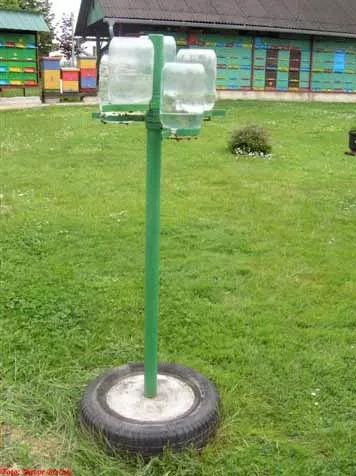
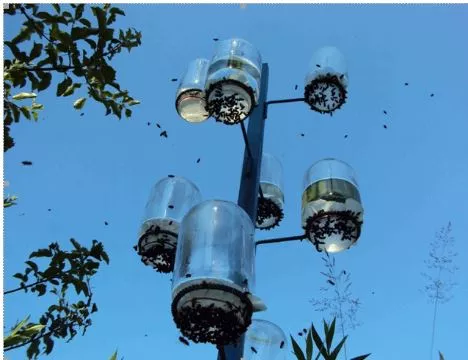

#2 Bee Watering Station With A Plastic Bucket
For this station, we need a plastic bucket that has a reinforced edge on top, with chambers. Holes should be drilled on the inside and then the bucket should be filled with water and tightly closed with a lid. Turn it over and place it on a stable stand made of bricks, blocks, etc. As the bees drink water, the fresh one will flow. According to the law of physics, water will never leak over the rim, but just enough to have enough water for bees in the rim of the bucket.
These types of watering stations are cheap, easy to make, and they can hold a lot of water, almost 20 liters. Three to four such stations are enough for a whole week in the apiary of twenty or more bee societies, in the peak of the heat.
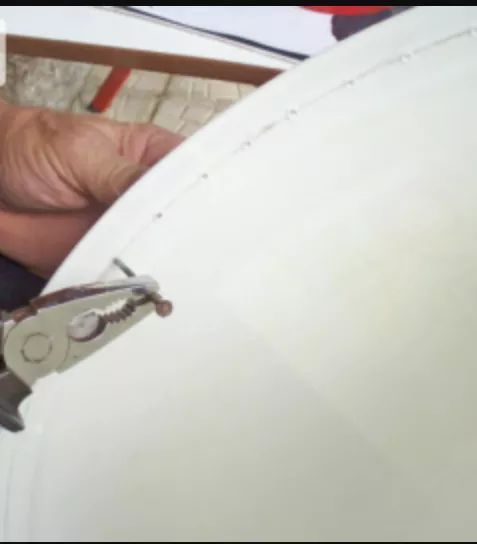
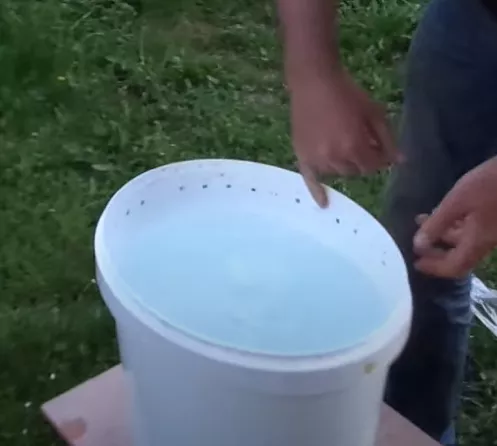

#3 Tapped Waterer With A Light Drip Of Water
You need a bucket or canister for this waterer (the bigger the bowl, the less water you will add). You need to drill a round hole in the bottom of the canister in the diameter of your tap. After that, place the tap by inserting it from the outside and screwing the thread that comes with the tap from the inside. Then pour the water, open the tap so that it comes out drop by drop.
In front of the tap, place one board that you have zigzagged so that the water goes through the slot you made on the board, and the bees can easily suck water from these channels.
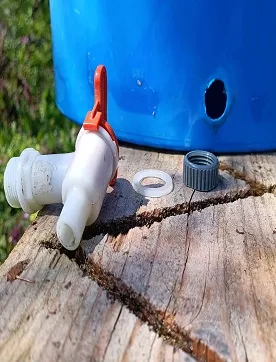
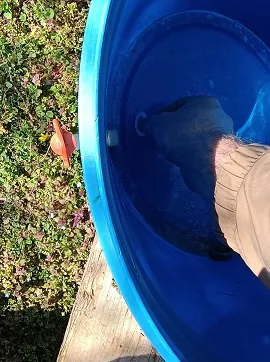
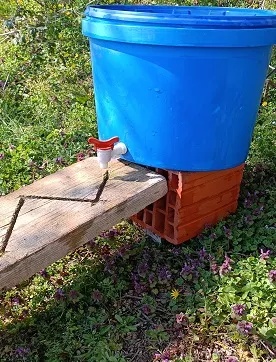
#4 Plastic Waterers Fixed On 5 Liter Bottles
You need to buy a plastic waterer that is filled with a 5 to 6 liter bottle of water, so that it practically changes the bottle cap. Then the bottle waterer is turned “upside down” and placed on a pre-prepared stand where it is fixed with nails or screws. As the bees consume the water from the watering station, the water from the bottle will be automatically replenished in the drinker.
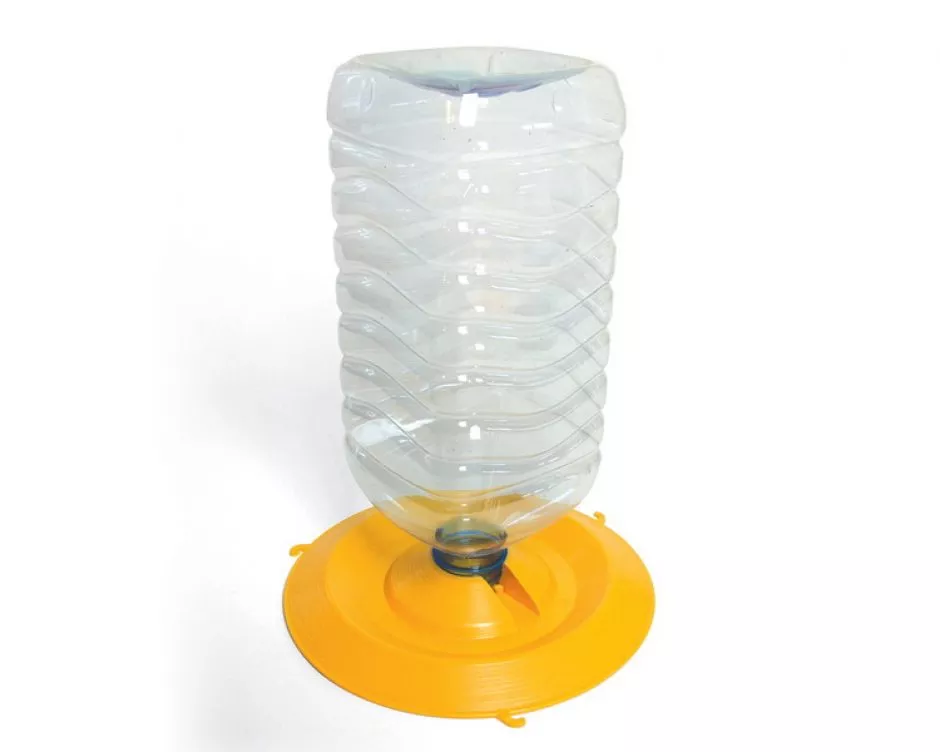
#5 Plastic Poultry Watering Station
After filling the station with water, you can place it on an already prepared stand or hang it on a tree. Chicken waterers work on the principle of gravity, the water will be gradually replenished in the stand from which the bees drink water. As with the previous suggestions, if the bowl of the station is more than a few centimeters deep, stones or marbles should be added.
If you have any more ideas on how to make bee watering stations yourself, feel free to share your ideas and experiences in the comments.
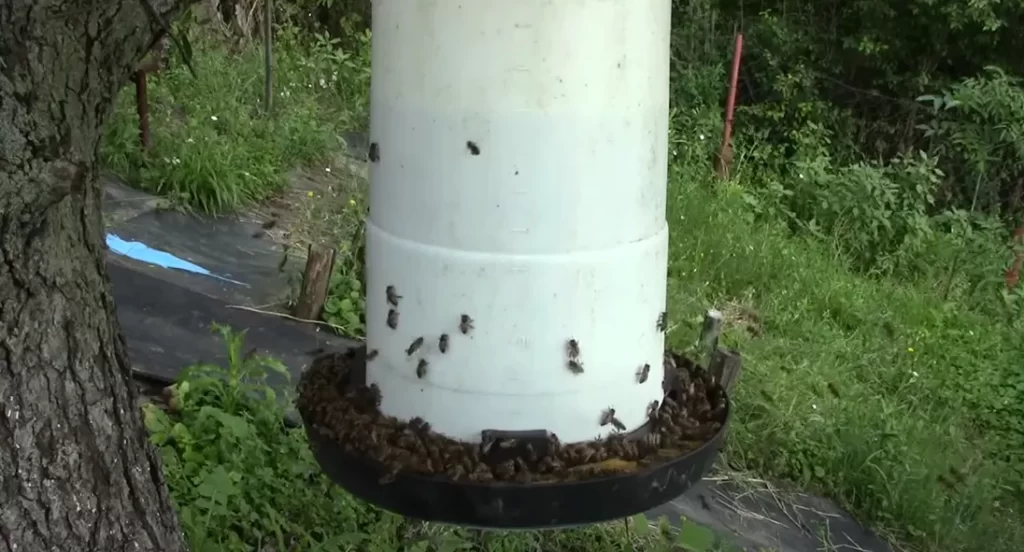
Should We Add Sugar Or Honey To The Water?
No! We do not need to add sugar or honey to the water because the sweetness in your water station will attract ants. Plain tap water is just fine.
Some beekeepers put salt in waterers. The practice of salting water is not good. It has been determined that 0.2-0.5% of salt in water shortens the life of bees, and concentrations higher than 1% are very toxic to them (table salt, NaCl – sodium chloride). Salts in water are mentioned many times in the literature, but they are mineral salts that are needed by all organisms, including bees.
Read article: How To Start Beekeeping? (A Complete Guide To Beekeeping)
How Do I Make Sure My Bee Waterer Is Safe?
Just as we wash our own glasses after drinking from them, so it is necessary to clean the bee watering stations. It can often happen that the beekeeper forgets to change the water and algae accumulate on the edges. Then it needs to be washed well and put clean.
It is also important to change it as often as possible, because in addition to bees, various other insects come to it, especially mosquitoes during hot weather, and if they see that the water has risen, they will lay eggs in it.
It is crucial to offer water for bees without the risk of drowning. If your water source is deep, simply add plugs, sticks or anything else that floats to give the bees a place to sit.
If you set the drinkers on time, the bees have long been accustomed to a constant source of clean water and will start visiting them regularly.
END
According to studies conducted in the United States, Switzerland and some other countries, an orderly supply of bees with water increases their productivity by 10 to 20%.
If you are a lover of nature, and small bees, do something similar in your gardens and orchards and make it easier for bees to get water, and they will be sweetly grateful.

